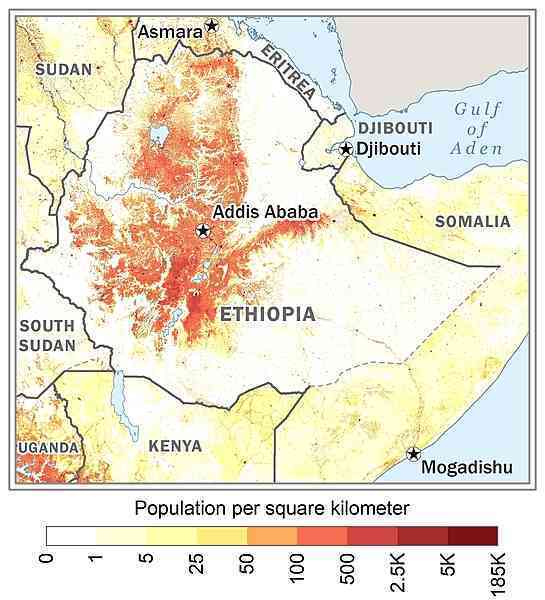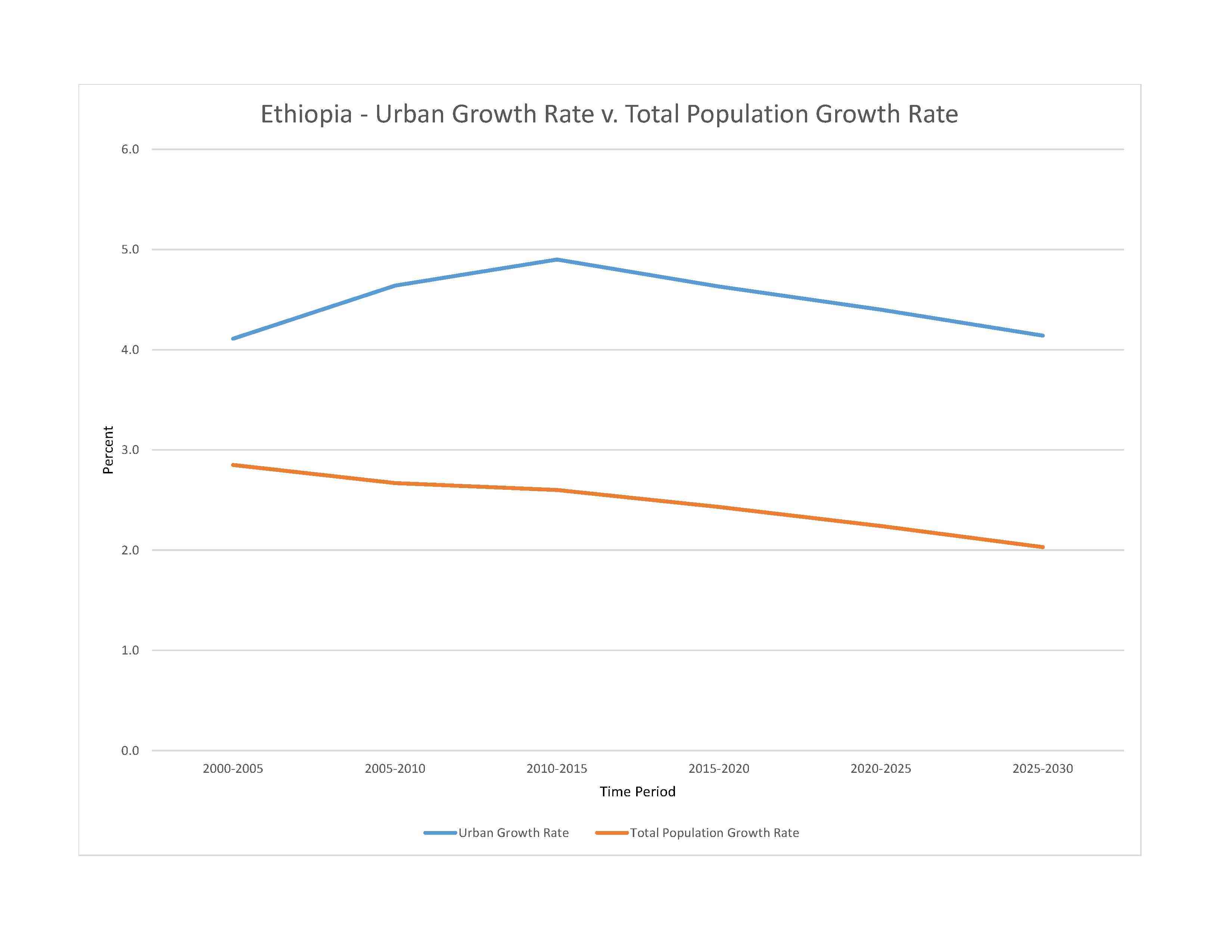
116,462,712 (2023 est.)
noun: Ethiopian(s)
adjective: Ethiopian
Oromo 35.8%, Amhara 24.1%, Somali 7.2%, Tigray 5.7%, Sidama 4.1%, Guragie 2.6%, Welaita 2.3%, Afar 2.2%, Silte 1.3%, Kefficho 1.2%, other 13.5% (2022 est.)
Oromo (official working language of Oromia Regional State) 33.8%, Amharic (official national language) 29.3%, Somali (official working language of Somali Regional State) 6.2%, Tigrigna (Tigrinya) (official working language of Tigray Regional State) 5.9%, Sidamo 4%, Wolaytta 2.2%, Gurage 2%, Afar (official working language of Afar Regional State) 1.7%, Hadiyya 1.7%, Gamo 1.5%, Gedeo 1.3%, Opuuo 1.2%, Kafa 1.1%, other 8.1%, English (major foreign language taught in schools), Arabic (2007 est.)
major-language sample(s):
Kitaaba Addunyaa Waan Qabataamaatiif - Kan Madda Odeeffannoo bu’uraawaatiif baay’ee barbaachisaa ta’e. (Oromo)
የአለም እውነታ መጽሐፍ፣ ለመሠረታዊ መረጃ እጅግ አስፈላጊ የሆነ ምንጭ። (Amharic)
The World Factbook, the indispensable source for basic information.
Ethiopian Orthodox 43.8%, Muslim 31.3%, Protestant 22.8%, Catholic 0.7%, traditional 0.6%, other 0.8% (2016 est.)
Ethiopia is a predominantly agricultural country – nearly 80% of the population lives in rural areas – that is in the early stages of demographic transition. Infant, child, and maternal mortality have fallen sharply over the past decade, but the total fertility rate has declined more slowly and the population continues to grow. The rising age of marriage and the increasing proportion of women remaining single have contributed to fertility reduction. While the use of modern contraceptive methods among married women has increased significantly from 6 percent in 2000 to 27 percent in 2012, the overall rate is still quite low.
Ethiopia’s rapid population growth is putting increasing pressure on land resources, expanding environmental degradation, and raising vulnerability to food shortages. With about 40 percent of the population below the age of 15 and a fertility rate of 4 children per woman (and even higher in rural areas), Ethiopia will have to make further progress in meeting its family planning needs if it is to achieve the age structure necessary for reaping a demographic dividend in the coming decades.
Poverty, drought, political repression, and forced government resettlement have driven Ethiopia’s internal and external migration since the 1960s. Before the 1974 revolution, only small numbers of the Ethiopian elite went abroad to study and then returned home, but under the brutal Derg regime thousands fled the country, primarily as refugees. Between 1982 and 1991 there was a new wave of migration to the West for family reunification. Since the defeat of the Derg in 1991, Ethiopians have migrated to escape violence among some of the country’s myriad ethnic groups or to pursue economic opportunities. Internal and international trafficking of women and children for domestic work and prostitution is a growing problem.
0-14 years: 38.91% (male 22,821,026/female 22,498,331)
15-64 years: 57.55% (male 33,345,764/female 33,672,933)
65 years and over: 3.54% (2023 est.) (male 1,887,831/female 2,236,827)
total dependency ratio: 75.7
youth dependency ratio: 70.2
elderly dependency ratio: 5.5
potential support ratio: 18.1 (2021 est.)
total: 20.2 years (2023 est.)
male: 20 years
female: 20.5 years
2.4% (2023 est.)
30.1 births/1,000 population (2023 est.)
6 deaths/1,000 population (2023 est.)
-0.1 migrant(s)/1,000 population (2023 est.)
highest density is found in the highlands of the north and middle areas of the country, particularly around the centrally located capital city of Addis Ababa; the far east and southeast are sparsely populated as shown in this 
urban population: 23.2% of total population (2023)
rate of urbanization: 4.4% annual rate of change (2020-25 est.)

5.461 million ADDIS ABABA (capital) (2023)
at birth: 1.03 male(s)/female
0-14 years: 1.01 male(s)/female
15-64 years: 0.99 male(s)/female
65 years and over: 0.84 male(s)/female
total population: 0.99 male(s)/female (2023 est.)
19.3 years (2019 est.)
note: data represents median age at first birth among women 20-49
267 deaths/100,000 live births (2020 est.)
total: 33.9 deaths/1,000 live births (2023 est.)
male: 38.8 deaths/1,000 live births
female: 28.8 deaths/1,000 live births
total population: 67.1 years (2023 est.)
male: 64.9 years
female: 69.4 years
3.92 children born/woman (2023 est.)
1.93 (2023 est.)
37.7% (2020)
improved: urban: 98.5% of population
rural: 70.2% of population
total: 76.4% of population
unimproved: urban: 1.5% of population
rural: 29.8% of population
total: 23.6% of population (2020 est.)
3.5% of GDP (2020)
0.11 physicians/1,000 population (2020)
0.3 beds/1,000 population (2016)
improved: urban: 52.5% of population
rural: 8.1% of population
total: 17.7% of population
unimproved: urban: 47.5% of population
rural: 91.9% of population
total: 82.3% of population (2020 est.)
degree of risk: very high (2023)
food or waterborne diseases: bacterial and protozoal diarrhea, hepatitis A, and typhoid fever
vectorborne diseases: malaria and dengue fever
water contact diseases: schistosomiasis
animal contact diseases: rabies
respiratory diseases: meningococcal meningitis
4.5% (2016)
total: 1.16 liters of pure alcohol (2019 est.)
beer: 0.92 liters of pure alcohol (2019 est.)
wine: 0 liters of pure alcohol (2019 est.)
spirits: 0.2 liters of pure alcohol (2019 est.)
other alcohols: 0.03 liters of pure alcohol (2019 est.)
total: 5.1% (2020 est.)
male: 8.8% (2020 est.)
female: 1.3% (2020 est.)
21.1% (2019)
67.5% (2023 est.)
women married by age 15: 14.1%
women married by age 18: 40.3%
men married by age 18: 5% (2016 est.)
4.5% of GDP (2019 est.)
definition: age 15 and over can read and write
total population: 51.8%
male: 57.2%
female: 44.4% (2017)
total: 9 years
male: 8 years
female: 8 years (2012)
NOTE: The information regarding Ethiopia on this page is re-published from the 2024 World Fact Book of the United States Central Intelligence Agency and other sources. No claims are made regarding the accuracy of Ethiopia 2024 information contained here. All suggestions for corrections of any errors about Ethiopia 2024 should be addressed to the CIA or the source cited on each page.
This page was last modified 04 May 24, Copyright © 2024 ITA all rights reserved.